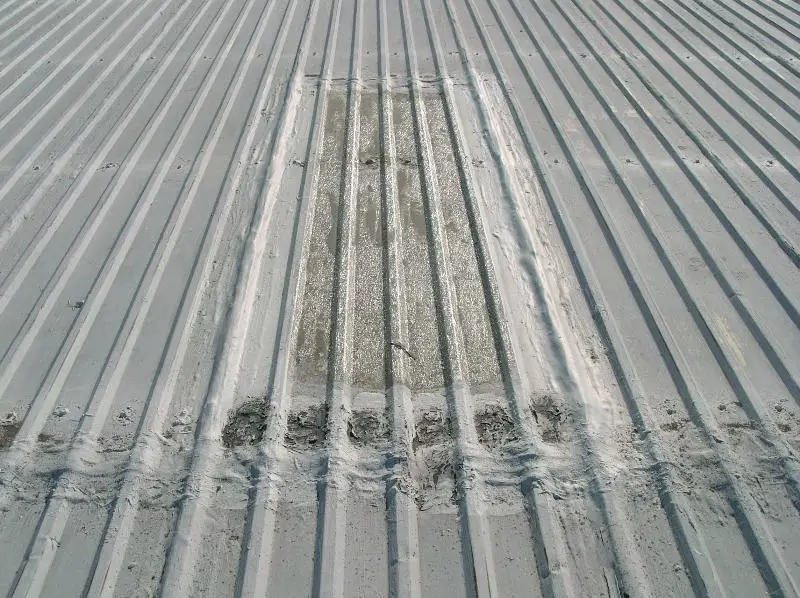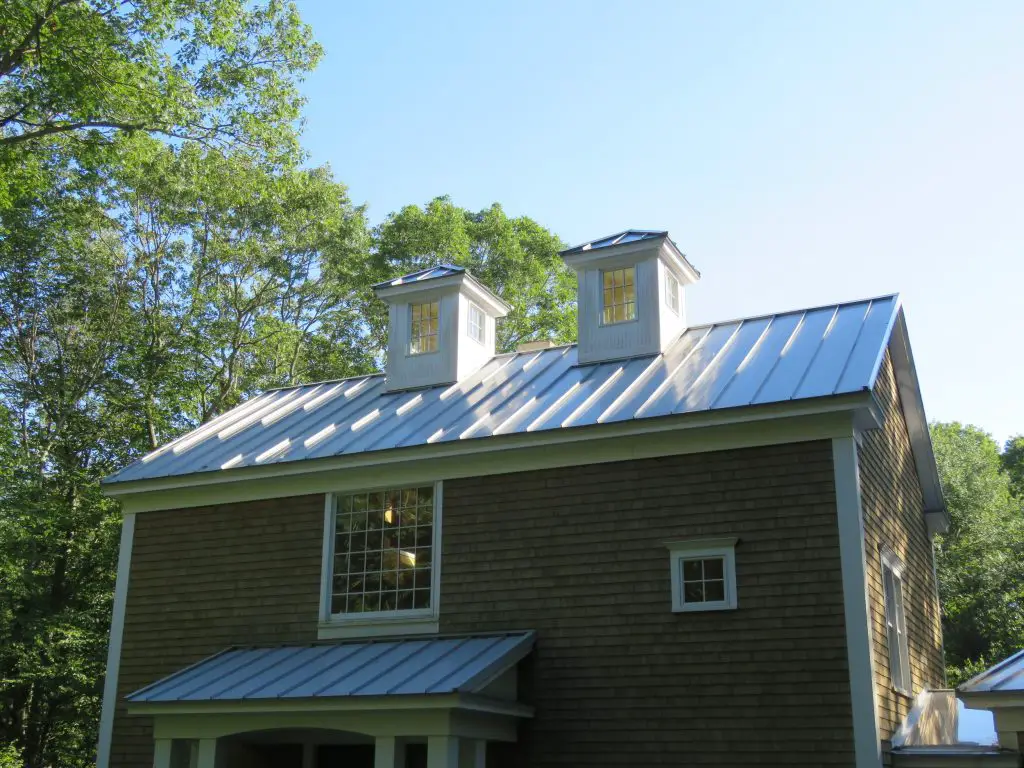Metal Roofing: Useful Information Guide
By Roof Online Staff • Last updated March 18, 2024

Types of Metal Used in Metal Roofing:
Aluminum Roofing – Aluminum roofing panels are a popular choice for both residential and commercial buildings. They are durable, lightweight, and resistant to corrosion, making them ideal for areas with high levels of moisture or salt exposure.
In addition, aluminum roofing panels are easy to install and require little maintenance, making them a cost-effective solution for many building projects.
Copper Roofing – Copper roofing is a premium roofing material that offers exceptional durability and longevity. Over time, copper develops a beautiful patina that enhances its aesthetic appeal. It is also an environmentally friendly material that can be recycled and used again.
While copper roofing may come at a higher cost, its durability and unique beauty make it a worthwhile investment for many property owners.
Galvalume – Galvalume roofing consists of steel roofing panels that are coated with a mixture of zinc and aluminum to protect against corrosion. It is known for its strength, durability, and ability to withstand extreme weather conditions. Galvalume roofing is also low maintenance, making it a popular choice for many commercial and industrial buildings.
Lead Roofing – Lead has been used as a roofing material for centuries due to its malleability, durability, and resistance to corrosion. It is commonly used in traditional and historic buildings, particularly in Europe. Lead roofing is also an excellent option for buildings with complex or curved roofs, as it can be easily shaped to fit any design.
However, due to the potential health and environmental hazards associated with lead, its use in roofing is becoming less common and is often subject to strict regulations.
Stainless Steel – Stainless steel roofing is a premium roofing material known for its exceptional strength and durability. It is highly resistant to corrosion, making it ideal for areas with high levels of moisture or salt exposure. Stainless steel roofing also offers a modern, sleek appearance that can complement a variety of architectural styles.
While it may come at a higher cost than other roofing materials, its longevity and low maintenance requirements can make it a cost-effective choice in the long run.
Steel Roofing – This is the most common type of metal roofing available. Steel roofing panels are a popular and affordable roofing material that offers excellent durability and longevity. They are highly resistant to impact, weather, and fire, making them a reliable choice for many building projects.
Steel panels typically have a coating applied at the factory to protect against corrosion. Because of these coatings, steel roofing panels are available in a variety of colors and styles, allowing them to complement various architectural designs.
They are also relatively low-cost, easy to install, and require minimal maintenance, making them a cost-effective solution for many property owners.
Zinc Roofing – Zinc roofing is a high-quality and durable roofing material that offers excellent corrosion resistance and longevity. It is a popular choice for modern architecture due to its sleek and unique appearance, which develops a subtle natural patina over time.
Zinc roofing is also a sustainable choice, as it is 100% recyclable and has a low environmental impact during production. While it may come at a higher cost than other roofing materials, its durability and aesthetic appeal make it a worthwhile investment for many property owners.
Types of Metal Roofing:
Flat Seam Metal Panels – Flat seam metal panels are a type of roofing material that features flat and smooth seams between panels. They are typically used on roofs or parts of a roof with a very low slope, and they have fully-soldered seams to prevent water intrusion. They are commonly made of copper, zinc, or stainless steel, and offer excellent durability and weather resistance.
Flat seam metal panels are known for their modern and sleek appearance, making them a popular choice for contemporary architectural designs. They require a high level of skill on the part of the roofer to install correctly.
Standing Seam Metal Panels – Standing seam metal panels are the most common type of metal roofing. Standing seam metal roofs consist of long, narrow panels that are installed perpendicular to the eave and ridge, with raised seams between panels that lock together.
They are commonly made of aluminum, steel, or copper, and offer excellent durability and weather resistance. Standing seam metal panels are known for their clean and modern appearance, and are a popular choice for both residential and commercial buildings. They can also be highly energy efficient, as they can reflect sunlight and reduce the amount of heat that enters the building.

Metal Shingles & Tiles – Metal shingles and tiles are a roofing material that imitate the appearance of traditional roofing materials such as wood, slate, or clay. They are typically made of steel, aluminum, or copper, and offer excellent durability and longevity.
While mimicking the appearance of other roofing materials, they offer the advantage of being cheaper or longer-lasting than those other materials.
Metal shingles and tiles are known for their versatility and aesthetic appeal, as they can complement various architectural styles. They are also extremely lightweight, which means they can be an option where heavier materials, like slate or tile, might not be.
Structural Metal Panels – Structural metal roofing panels are a type of roofing that serves as both the roof surface material and the structural deck. They are commonly made of steel or aluminum. Structural metal roofing panels can span long distances without the need for additional support, making them an ideal choice for industrial and commercial buildings.
Related Articles
- Copper Roofing
- Metal Roofing Manufacturers List
- Oil Canning in Metal Roof Panels
- Roof Decks
- Weight of Sheet Steel
External Sources & References for Metal Roofing Information
1. Book Recommendation: Manual of Low-Slope Roof Systems: Fourth Edition by C.W. Griffin & Richard Fricklas
2. General: See this informative, in-depth general article about various roof systems at the Whole Building Design Guide site, which is maintained by the National Institute of Building Sciences.
3. General: The Canadian Sheet Steel Building Institute’s website is an excellent source of all kinds of information, with many fact sheets and other resources available.
4. General: This article, “Cool Metal Roofing“, provides a decent overview of metal roofing in general, with emphasis on energy savings. It’s on the Whole Building Design Guide site.
5. General: “RICOWI Best Practices Guides for Roofing – Low Slope Metal” is available on the website of the Insurance Institute for Business & Home Safety. (“RICOWI” stands for the Roofing Industry Committee on Weather Issues).
6. General: “RICOWI Best Practices Guides for Roofing – Steep Slope Metal” is also available on the website of the Insurance Institute for Business & Home Safety.
7. Building Codes: “R905.10 Metal Roof Panels” from the 2021 International Residential Code and “1507.4 Metal Roof Panels” from the 2021 International Building Code. Both available on the UpCodes website.
8. Chemical Compatibility of various metals: see “Dissimilar Metal Corrosion” by D. Matthew Stuart, a four-page presentation with charts for quick reference. Found on the website of PDH Online.
9. Inspection of metal panel roof systems: ROOFER: Inventory Procedures and Inspection Manual for Metal Panel Roofing is a detailed and valuable resource put together by the US Army Corps of Engineers’ Engineer Research and Development Center. Available for download at the Defense Technical Information Center website.
10. Safety: See this material safety data sheet for health and safety information about aluminum at the Petersen Aluminum website. This is only an example and other products and brands may be different.
11. Safety: See this material safety data sheet for health and safety information about sheet steel at the Petersen Aluminum website. This is only an example and other products and brands may be different.
12. Technical: “Metal Roof Installation Manual” is probably the best, most thorough introduction to metal roofing you can find on the internet. Produced by the Metal Construction Association in 2014, it is available to MCA members as a free download from their Online Education Resources page, but it’s also on the ATAS International website.
13. Technical: “Technical Instructions – Structural Considerations for Metal Roofing“, prepared by the US Army Corps of Engineers; produced in 1998. From the document: “This document prescribes the criteria and procedures for designing metal roofs for buildings”.
14. Technical: “Testing and Specifying Metal Roofs in High Wind Areas” is a great source of information if you want to learn about wind and metal roofing. It’s a short course/long article originally published in 2021 and it’s available on BNP Media’s Continuing Education Center.